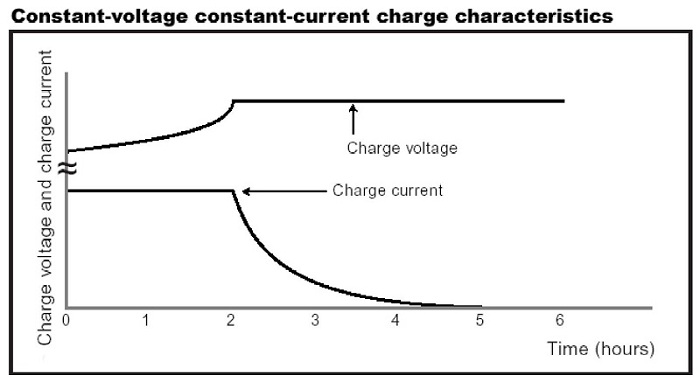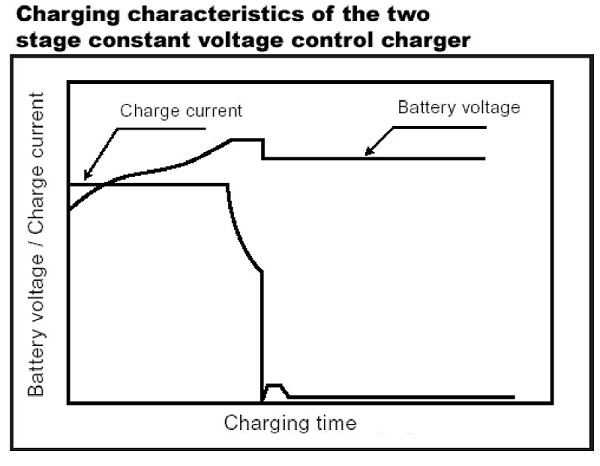Proper charging is one of the most important factors to consider when using maintenance-free sealed lead acid batteries. Battery performance and service life will be directly affected by the efficiency of the charger selected. Charging methods are dependent on battery applications like main power application and standby / backup power application.
Main power application (Cycle use):
a) Standard charging (Constant Voltage charging)
b) Rapid charging
Standby / backup power application (Trickle / Float use):
c) Trickle charging
d) Float charging
In a weekly series today we are going to discuss about the main power application (cycle use) charging methods first.
a) Standard charging (Constant Voltage charging)
For general applications of
VRLA battery, the constant voltage charging method is the most suitable and the recommended method of charging for EverExceed VRLA batteries as it allows the battery to exert full performance.
Constant Voltage Charging Method
The initial or equalize charge voltage for the EverExceed Deep Cycle
AGM Range batteries is 2.35volts per cell at 20ºC, limited charge current 0.25C.
Calculate the initial charge voltage for your installation based on either the number of cells in the string or the number of blocks in the string. Turn on the charger and raise the charger output voltage (using the equalization control) to the calculated value. Leave the string charging at this level for 24 hours. At the end of this time, reduce the charger output voltage to the float voltage level. See Section 6.2. Just prior to reducing the string voltage to the float voltage, measure the block voltages and charge current if possible.
If the charger output cannot be raised to the calculated initial charge voltage or the load cannot tolerate a charge voltage this high, raise the charger output voltage to the maximum permissible level. Measure the charger output voltage per cell. Use the following as a guideline:
Max. Voltage Charge Time Obtained (20ºC) (Hrs.) Min./Max.
2.33 - 2.35 VPC 12 / 24
2.31 - 2.33 VPC 36 / 48
At voltages below 2.29 VPC adequate equalization will not be obtained. Contact your EverExceed representative for additional details on procedures to equalize a battery under these conditions.
If the ambient temperature is not 20ºC, the initial charge voltage will have to be temperature compensated (TC). T C is the process whereby the charge voltage is changed as the function of the battery temperature. The temperature correction factor (TCF) for Deep Cycle AGM Range batteries is -0.003 volts / cell / ºC from a 20ºC baseline temperature.
As the battery temperature rises (falls) above (beneath) 20ºC, the charge voltage must be reduced raised) the TCF amount for every degree of change. The formula to calculate the temperature corrected voltage is:
TCV = CV (20ºC) +/- [T-20 ºC] x (-0.003 v/c)
As an example, if the initial charge were going to be performed at 32ºC the temperature corrected, reduced, charge voltage would be:
TCV = 2.35 - (32-20) x (-0.003 v/c) = 2.29 vpc

This method is to charge the battery by controlling the current at 0.25CA or smaller and controlling the voltage at 2.35 V/ per cell at an ambient temperature of 20°C to 25°C. Proper charging time is 6 to 12 hours depending on discharge rate.
b) Rapid charging
When rapidly charging the battery, a large charge current is required in a short time for replenishing the discharged energy.
Therefore, some adequate measures such as charging current controlling is required to prevent overcharging when the rapid charging is finished. Basic requirements for rapid charging are as follows:
Sufficient charging should be made in a short time for fully replenishing the discharged amount.
Charging current should be automatically controlled to avoid overcharging even on prolonged charging.
The battery should be charged adequately under the ambient temperature range of 0°C to 40°C.
Reasonable cycle life of charge / discharge should be secured.
Two-stage constant voltage charge control method is the typical methods to control charging so as to satisfy the above requirements.
Two-stage constant voltage charge control method
Two-stage constant voltage charge control method uses two constant-voltage devices. At the initial stage, the battery is charged by the first constant voltage device SW (1) of high setup voltage (setup for cycle charge voltage). When the charging current, the value of which is detected by the current-detection circuit, has reduced to the preset value, the device is switched over to the second SW (2) of low setup voltage (setup for trickle charge voltage). This method has the advantage that the battery in trickle use can be charged in a comparatively short time for the next discharge service.


